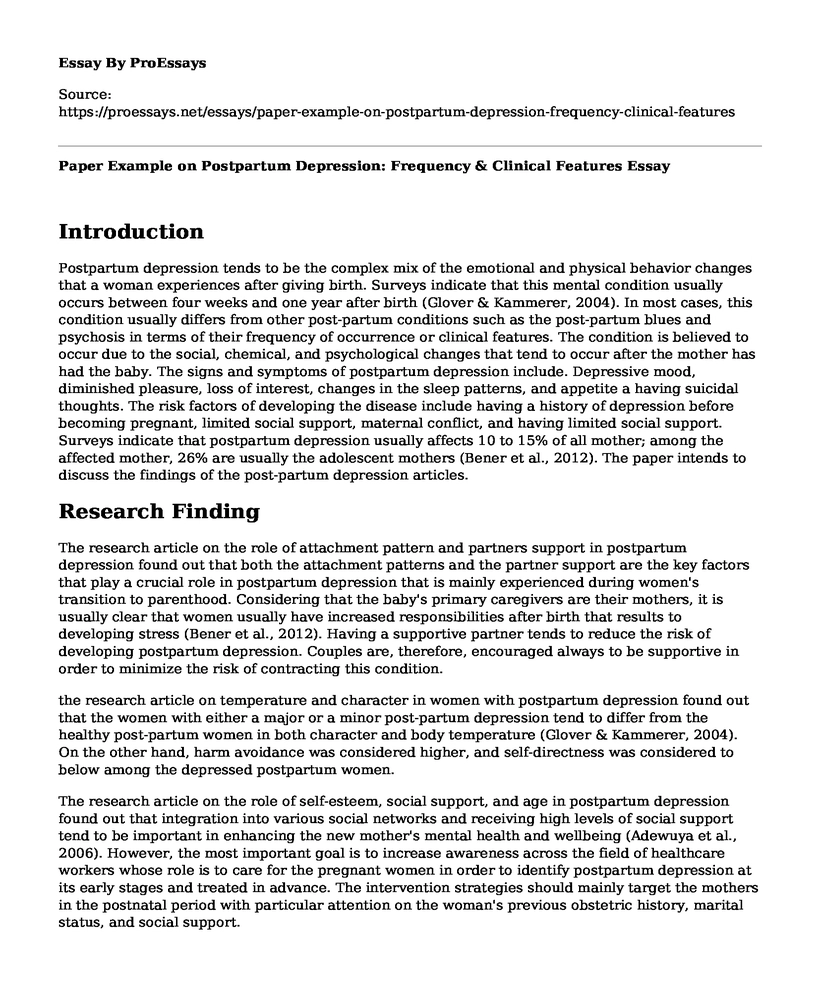Introduction
Postpartum depression tends to be the complex mix of the emotional and physical behavior changes that a woman experiences after giving birth. Surveys indicate that this mental condition usually occurs between four weeks and one year after birth (Glover & Kammerer, 2004). In most cases, this condition usually differs from other post-partum conditions such as the post-partum blues and psychosis in terms of their frequency of occurrence or clinical features. The condition is believed to occur due to the social, chemical, and psychological changes that tend to occur after the mother has had the baby. The signs and symptoms of postpartum depression include. Depressive mood, diminished pleasure, loss of interest, changes in the sleep patterns, and appetite a having suicidal thoughts. The risk factors of developing the disease include having a history of depression before becoming pregnant, limited social support, maternal conflict, and having limited social support. Surveys indicate that postpartum depression usually affects 10 to 15% of all mother; among the affected mother, 26% are usually the adolescent mothers (Bener et al., 2012). The paper intends to discuss the findings of the post-partum depression articles.
Research Finding
The research article on the role of attachment pattern and partners support in postpartum depression found out that both the attachment patterns and the partner support are the key factors that play a crucial role in postpartum depression that is mainly experienced during women's transition to parenthood. Considering that the baby's primary caregivers are their mothers, it is usually clear that women usually have increased responsibilities after birth that results to developing stress (Bener et al., 2012). Having a supportive partner tends to reduce the risk of developing postpartum depression. Couples are, therefore, encouraged always to be supportive in order to minimize the risk of contracting this condition.
the research article on temperature and character in women with postpartum depression found out that the women with either a major or a minor post-partum depression tend to differ from the healthy post-partum women in both character and body temperature (Glover & Kammerer, 2004). On the other hand, harm avoidance was considered higher, and self-directness was considered to below among the depressed postpartum women.
The research article on the role of self-esteem, social support, and age in postpartum depression found out that integration into various social networks and receiving high levels of social support tend to be important in enhancing the new mother's mental health and wellbeing (Adewuya et al., 2006). However, the most important goal is to increase awareness across the field of healthcare workers whose role is to care for the pregnant women in order to identify postpartum depression at its early stages and treated in advance. The intervention strategies should mainly target the mothers in the postnatal period with particular attention on the woman's previous obstetric history, marital status, and social support.
The article on early screening of postpartum depression using the Edinburg postnatal depression scale found out that the Edinburg postnatal depression scale is usually an effective tool in postpartum depression screening. The research indicated that the use of the scale during the first days after birth might help the clinicians in predicting or identifying the women who are at risk of getting postpartum depression (Beck & Indman, 2005). The finding also concluded that the women who are identified to have high scores as per the scale should be immediately referred to the physician for proper follow-up.
References
Adewuya, A. O., Ola, B. A., Dada, A. O., & Fasoto, O. O. (2006). Validation of the Edinburgh Postnatal Depression Scale as a screening tool for depression in late pregnancy among Nigerian women. Journal of Psychosomatic Obstetrics & Gynecology, 27(4), 267-272. https://doi.org/10.1080/01674820600915478
Bener, A., Gerber, L. M., & Sheikh, J. (2012). Prevalence of psychiatric disorders and associated risk factors in women during their postpartum period: a major public health problem and global comparison. International journal of women's health, 4, 191. https://www.ncbi.nlm.nih.gov/pmc/articles/PMC3363135/
Beck, C. T., & Indman, P. (2005). The many faces of postpartum depression. Journal of Obstetric, Gynecologic, & Neonatal Nursing, 34(5), 569-576. https://doi.org/10.1177/0884217505279995
Glover, V., & Kammerer, M. (2004). The Biology and Pathophysiology of Peripartum Psychiatric Disorders. Primary Psychiatry. https://psycnet.apa.org/record/2004-16244-002
Cite this page
Paper Example on Postpartum Depression: Frequency & Clinical Features. (2023, Mar 02). Retrieved from https://proessays.net/essays/paper-example-on-postpartum-depression-frequency-clinical-features
If you are the original author of this essay and no longer wish to have it published on the ProEssays website, please click below to request its removal:
- Moral Concerns and Committing Suicide Essay Example
- Research Paper on Stress and the Impacts It Has on the Quality of Life
- Examining Community Perceptions of the Relationships Between Cyber Bullying and Youth Suicide
- Essay on Child and Adolescent Development
- Post-Traumatic Stress Disorder Research Paper
- The Concept of Mental Health Essay Example
- ADHD: Prevalence Doubles Over Past Decades - Essay Sample







